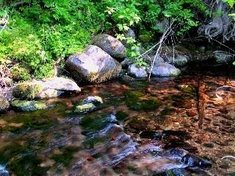
(Please click on image to enlarge the photo)
While I was away for the week-end at the Ranch, I left this picture for you, Dear Reader, to consider. It's a shelf that was in my cabin bedroom on Camano Island where I stayed during the Crochet Liberation Front retreat where I taught crochet hook carving. The cabin where I stayed was built in the 1930's and I'd expect that shelf was installed round bout then. I asked for your impressions in the remarks section here in my blog.
I Like your comments!
Now here are mine:
That shelf was just above the foot of the bed in my cabin on Camano Island, and it was the first thing I saw in the morning as I got up, the last as I turned off the light at night. And in between I was thinking about teaching hook carving to my students. Maybe that sets the stage a little. Or maybe that shelf would have evoked similar thoughts anyway, either way had an effect that I decided to write a bit about.
My first thought when I saw the shelf was what you'd expect. Sheesh that's really shoddy workmanship; a very shallow knee jerk reaction brought on by a lifetime of watching for "quality". Still in that negative mindset, I started thinking about the conditions at the time that shelf was constructed (I'd guess in the 30's when the little cabin was built). Then I wondered about what kind of saw was used to trim that corner, and how that brace was installed with ordinary hammer and nails without resulting in an out-of-level shelf; and how come the brace didn't have hammer marks yet that horizontal molding did. And what about the person who built and installed the shelf? Oh I had it as maybe a hobo working for a meal or a carpenter's son who was just learning the trade.
And it came to me that I was really REALLY enjoying looking at that simple old shelf that wasn't put together really that well. It was becoming comfortable, if that's a good choice of words. It fit. I was proud of the person who had the stuff to stand up and try, and if that was as best effort, then that was just fine... the shelf still does the job after all these years.
And then (here comes the epiphany) I wondered if I would have given that shelf even a second glance, had it been a plastic veneer covered particleboard plank with a plastic T mold edge sitting on a stamped metal shelf hanger, installed with a pneumatic finish nailer... something you'd expect to see. No,I thought,if I was to look at such a "modern" arrangement, I'd certainly not be inspired to wonder about the hands that did the installation. Certainly the more modern arrangement would have been MUCH more efficient to install and likely more accurate. Yet what legacy would have been left? Instead of leaving me with a warm curiosity about the carpenter, and a smile about the out-of-round curvature of that relief cut, saw marks and hammer indentations; I guarantee that if I'd paid the modern shelf any attention at all, it would have been, at best, a glance of indifference and maybe accompanied with a passing thought of derision at what a plastic world we've become.
Instead, that simple shelf made so obviously with hand tools, with very obvious tracks left by the carpenter's tools was actually inspirational. There is simple beauty in that work. Thinking about the old shelf, I left for my classes inspired that teaching people to use a knife to create a useful tool from a simple stick, is really is good thing to do. Simplicity is good. Doing things with your hands is good. Leaving tracks. Its more than good, there's a synergy.
Wabi Sabi? What do YOU think? Not the dictionary version, I expect, but there's more there than just "simple but gets the job done".
I invite your views in the comment section..
Jimbo















5 comments:
From wikipedia: Wabi Sabi represents a comprehensive Japanese world view or aesthetic centered on the acceptance of transience. The aesthetic is sometimes described as one of beauty that is "imperfect, impermanent and incomplete". It is a concept derived from the Buddhist assertion of the Three marks of existence, specifically impermanence.
Characteristics of the wabi-sabi aesthetic include asymmetry, asperity, simplicity, modesty, intimacy and the suggestion of natural processes
Very good April! You get an A. But now consider.... what would that picture have to do with Wabi Sabi?
Hmm, well, I can't tell from the picture if it is assymetrical or imperfect, but it is simple, modest, and possibly rough in texture (asperity is in the words of Webster's dictionary "roughness of surface". It appears to be very much in it's natural state, not finished or painted. You can see the grain lines on it which "suggest[s]...natural processes".
One thing about the shelf that first struck me was the imperfect hammering...near quite a few of the nails looks like bounce marks where the hammer missed the nail and dented the wood instead... there also looks like run marks where the wood stain has dripped down. It looks homely and stable and goes to show being perfect has nothing to do with usefulness
Wabi Sabi or no, I enjoyed your essay. We had that same shelf in our cabin too, and I have to say I didn't think about it all that much. I just tried not to smack my head on it when climbing in and out of bed. :-)
I did thoroughly enjoy your carving class at Cama. Every time I pick up one of the hooks that Dennis and I made or the hook I bought from you, I'm flooded with warm memories. Nothing that comes from a factory can compete with the tactile pleasure and beauty of those lovely hand made hooks. Thanks!
Post a Comment